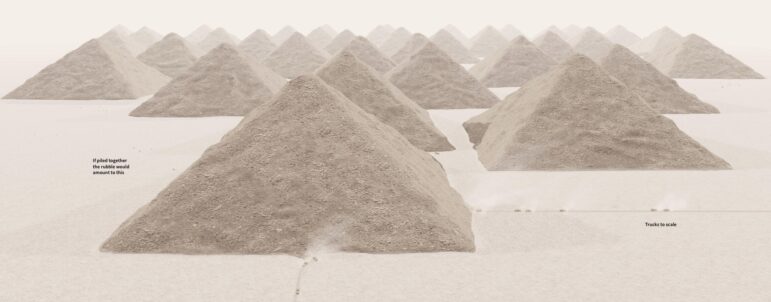Data Journalism Top Ten: Turkey’s Toxic Rubble, Eurovision History, and a Rare Climate Victory
newsletter via Feeds on Inoreader 2023-05-20
Summary:

Reuters offers a graphic visualization of the rubble pile left from the Turkey earthquake in February — estimated by the UN to be 100 million cubic meters (130 million cubic yards) — as the equivalent to 38 enormous heaps, each the size of the Great Pyramid in Giza, Egypt. Image: Screenshot, Reuters
From a visual exploration of the bombing of the Ukrainian city of Kharkiv to a project looking at the health impact of toxic debris from Turkey’s earthquake, data reporters have been examining the question of “what happens next.” Our Data Journalism Top 10 has been curated by GIJN, and features stories from May 8 to 14, 2023. Also featured: pop data from the Eurovision song contest, Latin American inflation, and a look at the height of world leaders through history. Plus, a game to ask readers how they would reduce the US national debt.
How Russia’s Invasion Transformed Kharkiv
To show how Russia’s invasion of Ukraine has transformed “everyday places” such as parks, universities, and city squares, a collaboration from Vox and The Pudding traced a route through the city of Kharkiv to show before-and-after damage to various community spaces. Readers can also compare the map of damaged landmarks in Kharkiv to US cities to consider how, for instance, a theater in Chicago would look if it suffered similar attacks. To create these maps and comparisons, the team pulled data from Google Trends and the Google Places API, and collected images from Google Streetview, Google Maps, and Getty Images.
Also interesting: Using satellite imagery, RFE/RL’s Ukrainian service mapped over 200 military objects located in Crimea, such as bases, fuel depots, and air defense systems.
What happens when war comes for your park? Your gym? Your grocery store?
A new interactive story from Vox and @puddingviz explores how Russia's invasion transformed the Ukrainian city of Kharkiv. https://t.co/M754icgqNn
— Vox (@voxdotcom) May 10, 2023
Turkey’s Secondary Disaster
Turkey’s February earthquake — which killed over 54,000 people in Turkey and Syria — may have “unleashed a health catastrophe for a generation” according to Reuters. It gathered data from various agencies and spoke with environmental health professionals and experts, some of whom believe a “secondary disaster” caused by toxic debris could be more severe than the quakes. Through satellite imagery and a striking visualization of the more than 300,000 damaged buildings — which are releasing poisons such as asbestos into the air and water — Reuters provides a new understanding of the scale of the catastrophe.
Also impressive is this deep dive — and 3-D model — by The New York Times exploring why one luxury building collapsed in Turkey.
A typical time-lapse process of one of the illustrated graphics included in our latest @ReutersGraphics project for this story about the toxic dust from Turkey's earthquakes. Done with iPad and @procreate https://t.co/df3qpnotgq pic.twitter.com/oHXqk5Juu8
— Adolfo Arranz (@adolfux)